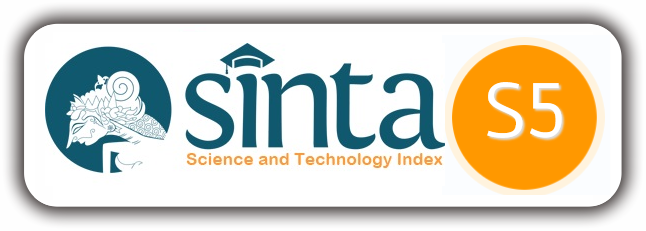Pengembangan Indikator Pemantauan dan Evaluasi Penggunaan Dana Desa (Studi pada Desa Sidoarum Kabupaten Sleman)
Asti Kartika Wijayanti(1*)
(1) Maksi FEB UGM
(*) Corresponding Author
Abstract
Keywords
Full Text:
PDFReferences
Ahyaruddin, M. and Akbar, R. 2016. The Relationship Between The Use of a Performance Measurement System, Organizational Factors, Accountability, and The Performance of Public Sector Organizations. Journal of Indonesian Economy and Business: JIEB. [Online]. 31(1),p.1. [Accessed 30 October 2016]. Available from: http://search.proquest.com/openview/bd5bb6039ac71ad407b1b4d48746e452/1?pq-origsite=gscholar&cbl=2029354.Akbar, R., Pilcher, R.A. and Perrin, B. 2015. Implementing performance measurement systems: Indonesian local government under pressure. Qualitative Research in Accounting & Management. [Online]. 12(1),pp.3–33. [Accessed 30 October 2016]. Available from:15http://www.emeraldinsight.com/doi/10.1108/QRAM-03-2013-0013.Akbar, R., Pilcher, R. and Perrin, B. 2012. Performance measurement in Indonesia: the case of local government R. Adler, ed. Pacific Accounting Review. [Online]. 24(3),pp.262–291. [Accessed 24 August 2016]. Available from: http://www.emeraldinsight.com/doi/abs/10.1108/01140581211283878.BPD Sidoarum. 2015. Laporan Penyelenggaraan Pemerintahan Desa Akhir Tahun Anggaran 2015 Desa Sidoarum Kecamatan Godean Kabupaten Sleman Daerah Istimewa Yogyakarta.BPKP. 2015. Standar Akuntansi dan Pelaporan Keuangan Dorong Akuntabilitas Desa. Warta Pengawasan. XXII/Edisi HUT Ke-70 RI,pp.14–15.Branch, R.M. 2010. Instructional Design: The ADDIE Approach. Springer US.Cavalluzzo, K.S. and Ittner, C.D. 2004. Implementing performance measurement innovations: evidence from government. Accounting, Organizations and Society. [Online]. 29(3–4),pp.243–267. [Accessed 5 October 2016]. Available from: http://www.sciencedirect.com/science/article/pii/S0361368203000138.Creswell, J. 2014. Research Design: Qualitative, Quantitative, and Mixed Approaches. Thousand Oaks, California: SAGE Publications.Deb, A.K. 2014. Economic Reforms, Capacity Utilization and Productivity Growth in Indian Manufacturing. Global Business Review. [Online]. 15(4),pp.719–746. [Accessed 8 November 2016]. Available from: http://gbr.sagepub.com/content/ 15/4/719.Deputi Bidang Pencegahan KPK. 2015. Laporan Hasil Kajian Pengelolaan Keuangan Desa: Alokasi Dana Desa dan Dana Desa. Jakarta: KPK.Friedman, M. 2005. Trying hard Is Not Good Enough (How to Produce Measurable Improvements for Customers and Communities). FPSI Publishing.Fujikake, Y. 2008. Qualitative Evaluation: Evaluating People’s Empowerent. Japanese Journal of Evaluation Studies. Vol 8 No 2(Japan Evaluation Society),pp.25–37.Gall, J., Gall, M. and Borg, W. 2005. Applying Educational Research: A Practical Guide. Boston: Pearson.Halim, A. 2014. Manajemen Keuangan Sektor Publik: Problematika Penerimaan dan Pengeluaran Pemerintah. Jakarta: Salemba Empat.Halim, A. 2011. Pengelolaan Keuangan Negara-Daerah: Hukum, Kerugian Negara, dan Badan Pemeriksa Keuangan I. Yogyakarta: UPP STIM YKPN.Halim, A., Syam Kusufi, M. and Paputungan, V. 2016. Teori, Konsep, dan Aplikasi Akuntansi Sektor Publik Dari Anggaran Hingga Laporan Keuangan Dari Pemerintah Hingga Tempat Ibadah 2nd ed. Jakarta: Salemba Empat.Hennink, M., Hutter, I. and Bailey, A. 2011. Qualitative Research Methods. London: Sage Publications Ltd.Ikhwanto, Y. 2016. Pengembangan Desain Instrumen Pemantauan dan Evaluasi Pengelolaan Barang Milik Negara/Daerah.Mackay, K. 1998. IEG. [Accessed 13 September 2016]. Available from: http://www.academia.edu/download/33128313/ME_better_gov_bahasa.pdf.16Mahmudi. 2007. Manajemen Kinerja Sektor Publik. Yogyakarta: UPP STIM YKPN.Mardiasmo. 2009. Akuntansi Sektor Publik. Yogyakarta: CV Andi Offset.Miles, M., Huberman, A. and Saldana, J. 1994. Qualitative Data Analysis: A Methods Sources Book Third. Los Angeles: SAGE publications Inc.Mubarak, Z. 2010. Evaluasi Pemberdayaan Masyarakat ditinjau dari Proses Pengembangan Kapasitas pada Kegiatan PNPM Mandiri Perkotaan di Desa Sastrodirjan Kabupaten Pekalongan.Muktiali, M. 2009. Penyusunan Instrumen Monitoring dan Evaluasi Manfaat Program Pembangunan di Kota Semarang. Jurnal RIPTEK Bappeda Kota Semarang. 3(2),pp.11–20.Mulyadi. 2007. Activity Based Cost System: Sistem Informasi Biaya untuk Pemberdayaan Karyawan, Pengurangan Biaya, dan Penentuan Secara Akurat Kos Produk dan Jasa. Yogyakarta: UPP STIM YKPN.Nugrohoardi, R. 2016. Evaluasi Sistem Perencanaan Penggunaan Dana Desa Studi Pada Pemerintah Kabupaten Ngawi.Perwakilan BPKP Daerah Istimewa Yogyakarta. 2016. Laporan Hasil Evaluasi Penggunaan Dana Desa Tahun 2015 dan SiLPA Dana Desa Tahun 2015 Kabupaten Bantul dan Kabupaten Gunung Kidul.Primarisanti, H. and Akbar, R. 2015. Factors Influencing the Success of Performance Measurement: Evidence from Local Government. Journal of Indonesian Economy and Business: JIEB. [Online]. 30(1),p.56. [Accessed 30 October 2016]. Available from:http://search.proquest.com/openview/4e19d329705a07448573e8e5a38b1cdf/1?pq-origsite=gscholar&cbl=2029354.Ratminto and Winarsih, A.S. 2006. Manajemen Pelayanan: Pengembangan Model Konseptual, Penerapan Citizen’s Character dan Standar Pelayanan Minimal. Yogyakarta: Pustaka Pelajar.Richey, R.C. and Klein, J.D. 2005. Developmental Research Methods: Creating Knowledge from Instructional Design and Development Practice. Journal of Computing in Higher Education. 16(2),pp.23–38.Ritonga, I.T. 2014. Analisis Laporan Keuangan Pemda. Yogyakarta: Lembaga Kajian Manajemen Pemerintah Daerah.Rossi, P.H., Lipsey, M.W. and Freeman, H.E. 2004. Evaluation A Systematic Approach Seventh. California: SAGE publications Inc.Sismudjito. 2014. The Societal Participation On The Regional Development. International Journal of Academic Research in Business and Social Sciences. [Online]. 4(12). [Accessed 30 October 2016]. Available from: http://hrmars.com/index.php/journals/papers/IJARBSS/v4-i12/1336.Tyler, R.W. 1969. Educational evaluation: new roles, new means. The sixty-eighth yearbook of the national society for the study of education. Part II. The national Society for the Study of Education.UNDP. 2002. Handbook on Monitoring and Evaluating for Results. [Accessed 4 February 2016]. Available from: http://web.undp.org/evaluation/documents/ handbook/me-handbook.pdf.Yin, R.K. 2014. Case Study Research Design and Methods 5th ed. California: SAGE publications Inc.
Article Metrics
Refbacks
- There are currently no refbacks.
This work is licensed under a Creative Commons Attribution 4.0 International License.
______________________________________________________________________________________________________
2302 - 1500


_logo2.png)





